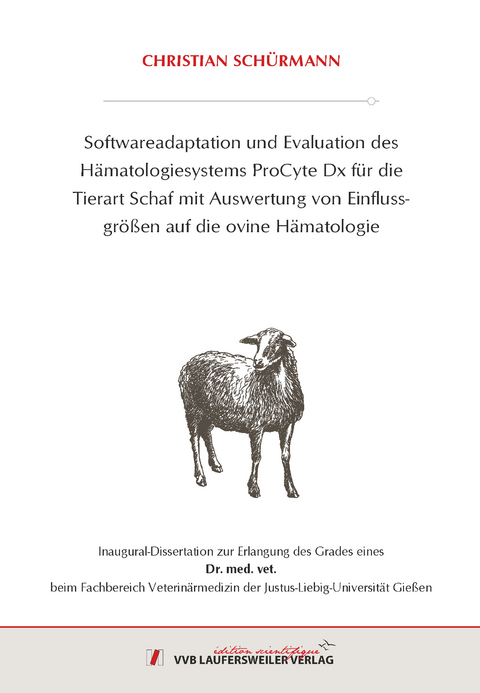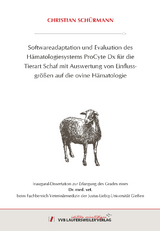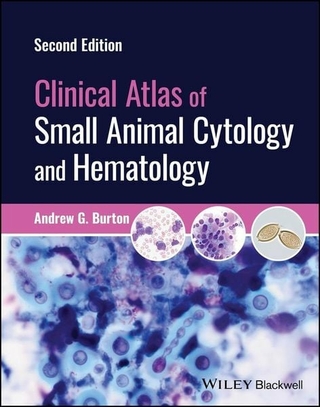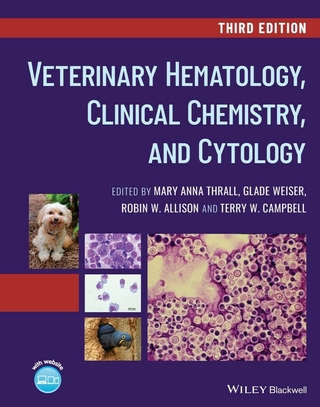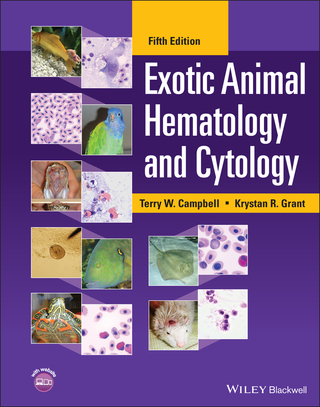Softwareadaptation und Evaluation des Hämatologiesystems ProCyte Dx für die Tierart Schaf mit Auswertung von Einflusgrößen auf die ovine Hämatologie
Seiten
2021
VVB Laufersweiler Verlag
978-3-8359-6952-0 (ISBN)
VVB Laufersweiler Verlag
978-3-8359-6952-0 (ISBN)
- Keine Verlagsinformationen verfügbar
- Artikel merken
Ziel der vorliegenden Arbeit war es, das Hämatologiesystem ProCyte Dx der Firma IDEXX Laboratories für die Tierart Schaf zu evaluieren und zu überprüfen, ob die Anämiediagnostik beim Schaf durch die Verwendung von Retikulozytenparametern verbessert werden kann.
Es wurden EDTA-Blutproben von 249 Schafen verwendet.
Ein Methodenvergleich erfolgte mit dem ADVIA 2120, dem Zentrifugenhämatokrit und der manuellen Differenzierung von 200 Leukozyten und 1000 Erythrozyten.
Die statistische Auswertung erfolgte über ein- und zweifaktorielle Varianzanalysen, lineare Regression, Passing-Bablok-Regressionsanalyse, Bland-Altman-Analyse und Bestimmung des Spearman´schen Rangkorrelationskoeffizienten.
Folgende relevante Ergebnisse wurden erzielt:
-Die Präzisionsmessung lieferte Variationskoeffizienten von 0,15 - 0,84 %
-Die Leukozytendifferenzierung liefert Variationskoeffizienten von 0,41 - 1,37 %, mit der Ausnahme der Monozyten. Hier liegt der Variationskoeffizient bei 4,67 %.
-Die Retikulozyten werden mit einem Variationskoeffizienten von 12,77 % gemessen.
-Die Verschleppung für das WBC ist bei 0,007 %.
-Eine Linearität für die Parameter RBC, Hb, WBC und PLT liegt vor.
-Der Antikoagulantienvergleich zeigt, dass die Nutzung von Na-Zitrat die RBC- Hb- und Hkt-Werte senkt. Heparin senkt die Thrombozytenzahlen.
-Im Lagerungsversuch ist der RBC für 24 Stunden stabil, danach steigen die Werte an. Die restlichen Erythrozytenparameter werden durch ein Anschwellen der Zellen nach zwölf Stunden der Lagerung verfälscht, die Thrombozytenkonzentration sinkt nach neun Stunden, die WBC-Werte sind für 48 Stunden stabil.
-Der Methodenvergleich zwischen ProCyte Dx und ADVIA 2120 zeigt für die Parameter WBC, RBC, Hb und Hb korrigiert Rangkorrelationskoeffizienten von rs = 0,976 - 0,994. Der Mittelwert-unterschied schwankt von -1,00 - 1,19.Der Hkt wird mit rs = 0,747 berechnet, Bias von -0,01. Das MCV korreliert nicht mit einem rs = -0,108 und einem Bias von -0,20. MCH und MCH korrigiert haben einen rs = 0,732, das MCHC und MCHC korrigiert einen rs = -0,755, eine Regression kann nicht berechnet werden. Optisch bestimmte Thrombozyten korrelieren mit einem rs = 0,738 und per Impedanz gemessen mit rs = 0,548.
-Die Leukozytendifferenzierung erfolgt für das WBC, neutrophile und eosinophile Granulozyten und Lymphozyten mit rs = 0,994, 0,952, 0,994 und 0,929. Der Bias liegt zwischen -1,00 und -0,02. Die Monozytendifferenzierung zeigt einen rs = 0,190 mit einem Bias von -0,36. Der Vergleich mit der manuellen Auszählung liefert für die neutrophilen Granulozyten ein rs = 0,903, Lymphozyten rs = 0,857, eosinophile Granulozyten rs = 0,850 und Monozyten rs = 0,503.
-Die Retikulozytenbestimmung des ProCyte Dx korreliert mit dem ADVIA 2120 mit einem rs = 0,708, Bias 4,70 mit Grenzen von -3,80 - 13,3. Die Hämoglobinmessung der Retikulozyten korreliert nicht rs = -0,060. Der Vergleich mit der manuellen Auszählung der Retikulozyten korreliert nicht mit den Messergebnissen des ProCyte Dx: rs = 0,068.
-Ein geringgradiger Rasseeinfluss auf die Blutparameter konnte nachgewiesen werden. Das Ausmaß ist so gering, dass eine Beachtung für die Bewertung der Hämatologie nicht notwendig ist.
-Es liegt ein deutlicher Alterseinfluss auf die Hämatologie des Schafes vor. Für eine genaue Differenzierung des Alterseinflusses muss besondere Beachtung dem Alter von ca. 2 Wochen und 3 Monaten geschenkt werden.
-Eine Beeinflussung der Hämatologie durch das Geschlecht wurde nicht nachgewiesen. Auf Grund der niedrigen Anzahl adulter männlicher Probanden ist das Ergebnis als nicht sicher einzustufen.
-Die Retikulozytenparameter liefern in dieser Arbeit nur geringe Korrelationen mit den übrigen hämatologischen Parametern. Erstmals wurde der Hämoglobingehalt der Retikulozyten für die Tierart Schaf gemessen. Auf Grund der hohen Varianz der Messergebnisse lässt dieser Parameter keine Rückschlüsse in der Anämiediagnostik zu. The aim of the present work was to evaluate the ProCyte Dx hematology system from IDEXX Laboratories for the sheep species and to verify whether anemia diagnostics in sheep can be improved by using reticulocyte parameters.
EDTA blood samples from 249 sheep were used.
A method comparison was made using the ADVIA 2120, centrifuge hematocrit, and manual differentiation of 200 leukocytes and 1000 erythrocytes.
Statistical analysis was performed using one- and two-factorial analyses of variance, linear regression, Passing-Bablok regression analysis, Bland-Altman analysis, and determination of Spearman's rank correlation coefficient.
The following relevant results were obtained:
-The precision measurement provided coefficients of variation of 0.15-0.84 %
-Leukocyte differentiation yields coefficients of variation of 0.41 - 1.37 %, with the exception of monocytes (coefficient of variation: 4.67 %).
-Reticulocytes are measured with a coefficient of variation of 12.77 %.
-The carryover for the WBC is at 0.007 %.
-Linearity is present for the parameters RBC, Hb, WBC and PLT.
-Anticoagulant comparison shows that the use of Na citrate lowers RBC Hb and Hct levels. Heparin lowers platelet counts.
-In the storage experiment, RBC is stable for 24 hours, after which the values increase. The remaining erythrocyte parameters are distorted by swelling of the cells after 12 hours of storage, platelet concentration decreases after nine hours, WBC values are stable for 48 hours.
-Method comparison between ProCyte Dx and ADVIA 2120 shows rank correlation coefficients of rs = 0.976 - 0.994 for the parameters WBC, RBC, Hb and Hb corrected. The mean difference varies from -1.00 - 1.19. Hct is calculated with an rs = 0.747, bias of -0.01. MCV is presented with an rs = -0.108 and bias of -0.20. MCH and MCH corrected have an rs = 0.732, MCHC and MCHC corrected have an rs = -0.755, regression cannot be calculated. Optically determined platelets correlate with an rs = 0.738 and measured by impedance with rs = 0.548.
-Leukocyte differentiation is for WBC, neutrophil and eosinophil granulocytes and lymphocytes with rs = 0.994, 0.952, 0.994 and 0.929, respectively. The bias is between -1.00 and -0.02. Monocyte differentiation shows an rs = 0.190 with a bias of -0.36. Comparison with manual enumeration yields an rs = 0.903 for neutrophil granulocytes, lymphocytes rs = 0.857, eosinophil granulocytes rs = 0.850, and monocytes rs = 0.503.
-Reticulocyte determination of ProCyte Dx correlates with ADVIA 2120 with an rs = 0.708, bias 4.70 with limits of -3.80 - 13.3. Hemoglobin measurement of reticulocytes does not correlate rs = -0.060. Comparison with manual counting of reticulocytes does not correlate with ProCyte Dx measurement results: rs = 0.068.
-A minor breed influence on the blood parameters could be demonstrated. The extent is so small that attention is not necessary for the evaluation of hematology.
-There is a clear age influence on the hematology of the sheep. For an exact differentiation of the age influence, special attention must be paid to the age of approx. 2 weeks and 3 months.
-An influence of gender on hematology was not demonstrated. Due to the limited number of subjects, the result is not to be considered reliable.
-The reticulocyte parameters provide only low correlations with the other hematological parameters in this work. For the first time, the hemoglobin content of the reticulocytes was measured in sheep. Due to the high variance of the measurement results, this parameter does not allow conclusions in anemia diagnostics.
Es wurden EDTA-Blutproben von 249 Schafen verwendet.
Ein Methodenvergleich erfolgte mit dem ADVIA 2120, dem Zentrifugenhämatokrit und der manuellen Differenzierung von 200 Leukozyten und 1000 Erythrozyten.
Die statistische Auswertung erfolgte über ein- und zweifaktorielle Varianzanalysen, lineare Regression, Passing-Bablok-Regressionsanalyse, Bland-Altman-Analyse und Bestimmung des Spearman´schen Rangkorrelationskoeffizienten.
Folgende relevante Ergebnisse wurden erzielt:
-Die Präzisionsmessung lieferte Variationskoeffizienten von 0,15 - 0,84 %
-Die Leukozytendifferenzierung liefert Variationskoeffizienten von 0,41 - 1,37 %, mit der Ausnahme der Monozyten. Hier liegt der Variationskoeffizient bei 4,67 %.
-Die Retikulozyten werden mit einem Variationskoeffizienten von 12,77 % gemessen.
-Die Verschleppung für das WBC ist bei 0,007 %.
-Eine Linearität für die Parameter RBC, Hb, WBC und PLT liegt vor.
-Der Antikoagulantienvergleich zeigt, dass die Nutzung von Na-Zitrat die RBC- Hb- und Hkt-Werte senkt. Heparin senkt die Thrombozytenzahlen.
-Im Lagerungsversuch ist der RBC für 24 Stunden stabil, danach steigen die Werte an. Die restlichen Erythrozytenparameter werden durch ein Anschwellen der Zellen nach zwölf Stunden der Lagerung verfälscht, die Thrombozytenkonzentration sinkt nach neun Stunden, die WBC-Werte sind für 48 Stunden stabil.
-Der Methodenvergleich zwischen ProCyte Dx und ADVIA 2120 zeigt für die Parameter WBC, RBC, Hb und Hb korrigiert Rangkorrelationskoeffizienten von rs = 0,976 - 0,994. Der Mittelwert-unterschied schwankt von -1,00 - 1,19.Der Hkt wird mit rs = 0,747 berechnet, Bias von -0,01. Das MCV korreliert nicht mit einem rs = -0,108 und einem Bias von -0,20. MCH und MCH korrigiert haben einen rs = 0,732, das MCHC und MCHC korrigiert einen rs = -0,755, eine Regression kann nicht berechnet werden. Optisch bestimmte Thrombozyten korrelieren mit einem rs = 0,738 und per Impedanz gemessen mit rs = 0,548.
-Die Leukozytendifferenzierung erfolgt für das WBC, neutrophile und eosinophile Granulozyten und Lymphozyten mit rs = 0,994, 0,952, 0,994 und 0,929. Der Bias liegt zwischen -1,00 und -0,02. Die Monozytendifferenzierung zeigt einen rs = 0,190 mit einem Bias von -0,36. Der Vergleich mit der manuellen Auszählung liefert für die neutrophilen Granulozyten ein rs = 0,903, Lymphozyten rs = 0,857, eosinophile Granulozyten rs = 0,850 und Monozyten rs = 0,503.
-Die Retikulozytenbestimmung des ProCyte Dx korreliert mit dem ADVIA 2120 mit einem rs = 0,708, Bias 4,70 mit Grenzen von -3,80 - 13,3. Die Hämoglobinmessung der Retikulozyten korreliert nicht rs = -0,060. Der Vergleich mit der manuellen Auszählung der Retikulozyten korreliert nicht mit den Messergebnissen des ProCyte Dx: rs = 0,068.
-Ein geringgradiger Rasseeinfluss auf die Blutparameter konnte nachgewiesen werden. Das Ausmaß ist so gering, dass eine Beachtung für die Bewertung der Hämatologie nicht notwendig ist.
-Es liegt ein deutlicher Alterseinfluss auf die Hämatologie des Schafes vor. Für eine genaue Differenzierung des Alterseinflusses muss besondere Beachtung dem Alter von ca. 2 Wochen und 3 Monaten geschenkt werden.
-Eine Beeinflussung der Hämatologie durch das Geschlecht wurde nicht nachgewiesen. Auf Grund der niedrigen Anzahl adulter männlicher Probanden ist das Ergebnis als nicht sicher einzustufen.
-Die Retikulozytenparameter liefern in dieser Arbeit nur geringe Korrelationen mit den übrigen hämatologischen Parametern. Erstmals wurde der Hämoglobingehalt der Retikulozyten für die Tierart Schaf gemessen. Auf Grund der hohen Varianz der Messergebnisse lässt dieser Parameter keine Rückschlüsse in der Anämiediagnostik zu. The aim of the present work was to evaluate the ProCyte Dx hematology system from IDEXX Laboratories for the sheep species and to verify whether anemia diagnostics in sheep can be improved by using reticulocyte parameters.
EDTA blood samples from 249 sheep were used.
A method comparison was made using the ADVIA 2120, centrifuge hematocrit, and manual differentiation of 200 leukocytes and 1000 erythrocytes.
Statistical analysis was performed using one- and two-factorial analyses of variance, linear regression, Passing-Bablok regression analysis, Bland-Altman analysis, and determination of Spearman's rank correlation coefficient.
The following relevant results were obtained:
-The precision measurement provided coefficients of variation of 0.15-0.84 %
-Leukocyte differentiation yields coefficients of variation of 0.41 - 1.37 %, with the exception of monocytes (coefficient of variation: 4.67 %).
-Reticulocytes are measured with a coefficient of variation of 12.77 %.
-The carryover for the WBC is at 0.007 %.
-Linearity is present for the parameters RBC, Hb, WBC and PLT.
-Anticoagulant comparison shows that the use of Na citrate lowers RBC Hb and Hct levels. Heparin lowers platelet counts.
-In the storage experiment, RBC is stable for 24 hours, after which the values increase. The remaining erythrocyte parameters are distorted by swelling of the cells after 12 hours of storage, platelet concentration decreases after nine hours, WBC values are stable for 48 hours.
-Method comparison between ProCyte Dx and ADVIA 2120 shows rank correlation coefficients of rs = 0.976 - 0.994 for the parameters WBC, RBC, Hb and Hb corrected. The mean difference varies from -1.00 - 1.19. Hct is calculated with an rs = 0.747, bias of -0.01. MCV is presented with an rs = -0.108 and bias of -0.20. MCH and MCH corrected have an rs = 0.732, MCHC and MCHC corrected have an rs = -0.755, regression cannot be calculated. Optically determined platelets correlate with an rs = 0.738 and measured by impedance with rs = 0.548.
-Leukocyte differentiation is for WBC, neutrophil and eosinophil granulocytes and lymphocytes with rs = 0.994, 0.952, 0.994 and 0.929, respectively. The bias is between -1.00 and -0.02. Monocyte differentiation shows an rs = 0.190 with a bias of -0.36. Comparison with manual enumeration yields an rs = 0.903 for neutrophil granulocytes, lymphocytes rs = 0.857, eosinophil granulocytes rs = 0.850, and monocytes rs = 0.503.
-Reticulocyte determination of ProCyte Dx correlates with ADVIA 2120 with an rs = 0.708, bias 4.70 with limits of -3.80 - 13.3. Hemoglobin measurement of reticulocytes does not correlate rs = -0.060. Comparison with manual counting of reticulocytes does not correlate with ProCyte Dx measurement results: rs = 0.068.
-A minor breed influence on the blood parameters could be demonstrated. The extent is so small that attention is not necessary for the evaluation of hematology.
-There is a clear age influence on the hematology of the sheep. For an exact differentiation of the age influence, special attention must be paid to the age of approx. 2 weeks and 3 months.
-An influence of gender on hematology was not demonstrated. Due to the limited number of subjects, the result is not to be considered reliable.
-The reticulocyte parameters provide only low correlations with the other hematological parameters in this work. For the first time, the hemoglobin content of the reticulocytes was measured in sheep. Due to the high variance of the measurement results, this parameter does not allow conclusions in anemia diagnostics.
| Erscheinungsdatum | 28.04.2021 |
|---|---|
| Reihe/Serie | Edition Scientifique |
| Verlagsort | Gießen |
| Sprache | deutsch |
| Maße | 148 x 210 mm |
| Gewicht | 170 g |
| Themenwelt | Veterinärmedizin ► Klinische Fächer ► Hämatologie |
| Veterinärmedizin ► Großtier ► Schaf / Ziege | |
| Schlagworte | Doktorarbeit • Schafe • Tiermedizin |
| ISBN-10 | 3-8359-6952-8 / 3835969528 |
| ISBN-13 | 978-3-8359-6952-0 / 9783835969520 |
| Zustand | Neuware |
| Informationen gemäß Produktsicherheitsverordnung (GPSR) | |
| Haben Sie eine Frage zum Produkt? |
Mehr entdecken
aus dem Bereich
aus dem Bereich
Buch | Hardcover (2024)
Wiley-Blackwell (Verlag)
137,17 €
Buch | Hardcover (2022)
Wiley-Blackwell (Verlag)
93,90 €
